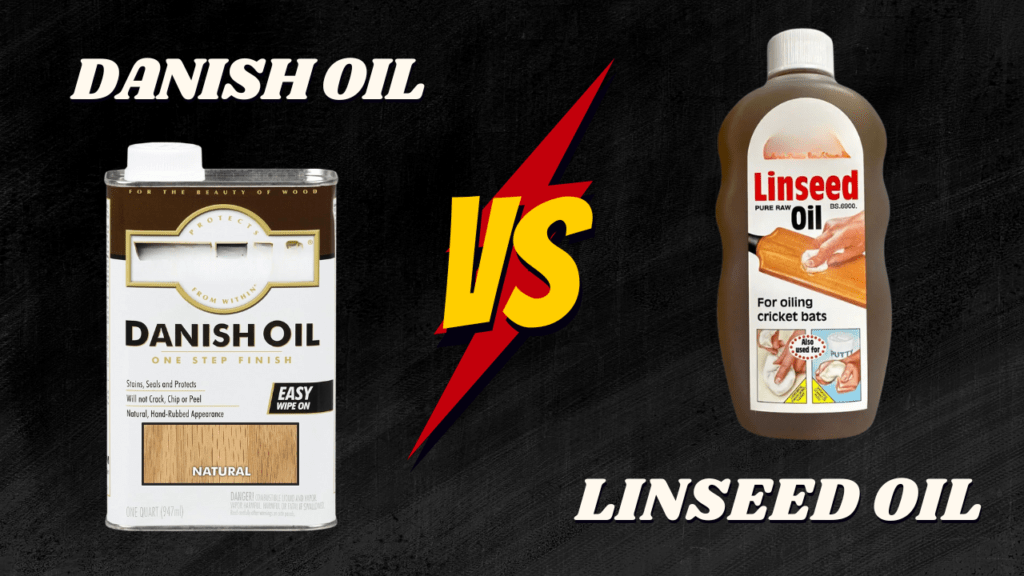
Natural oils have been used for centuries to protect and beautify wooden surfaces. Among the most popular choices, Danish oil and linseed oil are often compared because both enhance the natural grain of wood while providing protection. However, their composition, durability, and suitability for different projects make them distinct.
This guide will compare Danish oil vs linseed oil in detail, explaining their properties, advantages, disadvantages, and best uses so that the right finish can be selected for woodworking projects.
What Is Danish Oil?
Danish oil is not just one natural oil; it is a mix of oil (usually tung or linseed oil), varnish, and solvents. This blend helps the oil soak into the wood, protect it, and dry faster. The exact formula varies by manufacturer.
- Composition: Typically a mixture of polymerized oil and synthetic resins, giving it a balance of natural penetration and protective coating.
- Appearance: Produces a low-sheen satin to semi-gloss finish, enhancing the natural wood grain without being overly glossy.
- Drying and curing: Dries faster than raw linseed oil, often within 6–24 hours between coats, depending on the brand.
- Durability: More durable than pure oils due to the varnish component, providing better resistance against water, heat, and scratches.
- Safety: Food safety depends on the specific blend. Some Danish oils marketed as food-safe can be used on cutting boards, bowls, and utensils, but others are designed only for furniture and flooring.
What Is Linseed Oil?
Linseed oil is a natural oil extracted from flax seeds and has been used for generations as a wood preservative and finish.
- Types of linseed oil:
- Raw linseed oil: Natural and safe but extremely slow to dry (up to several weeks).
- Boiled linseed oil (BLO): Contains drying agents to speed up curing but may not be food-safe.
- Polymerized linseed oil: Heat-treated without chemicals, offering faster drying and a safe finish.
- Appearance: Adds a warm golden-orange tint and provides a satin finish. Over time, it tends to yellow or darken when exposed to sunlight.
- Drying and curing: Raw linseed oil is the slowest drying oil, while polymerized and boiled forms dry within 1–2 days.
- Durability: Provides moderate resistance to wear and moisture but is less protective than Danish oil.
- Safety: Raw and polymerized versions are food-safe, while BLO should not be used on food-contact surfaces.
Danish Oil vs Linseed Oil: Key Differences
| Feature | Danish Oil | Linseed Oil (Raw / Boiled / Polymerized) |
| Composition | Blend of oil, varnish, and solvents | Pure oil from flax seeds |
| Drying Time | 6–24 hours between coats | Raw: weeks; Polymerized: 1–2 days; BLO: ~1 day |
| Finish | Satin to semi-gloss, enhances grain | Satin, golden tint, yellows with age |
| Durability | Stronger, more resistant to water, heat, scratches | Moderate, less protective than blends |
| Food-Safe | Depends on formula (some safe, some not) | Raw/polymerized safe; BLO not recommended |
| Best For | Furniture, flooring, high-use surfaces | Indoor furniture, decorative items, utensils |
| Cost | Moderate to high (brand-dependent) | Affordable and widely available |
Which Oil Should Be Chosen?
- Danish oil should be selected for projects where durability and faster drying are priorities. It is suitable for furniture, flooring, and wood exposed to moderate wear and tear.
- Linseed oil should be chosen for budget-friendly, natural finishing projects, especially when a traditional satin sheen is desired for indoor furniture and crafts.
- For food-contact surfaces, pure polymerized linseed oil or Danish oils labeled as food-safe are the safest choices.
Advantages of Danish Oil
- Faster drying compared to raw linseed oil
- Provides a more durable protective finish
- Enhances wood grain with a natural satin look
- Better resistance against water, heat, and stains
- Easy to apply and maintain with re-coating
Advantages of Linseed Oil
- 100% natural in raw and polymerized forms
- Affordable and widely available
- Deeply penetrates wood fibers for a rich finish
- Ideal for antique restoration and traditional finishes
- Safe for food-contact surfaces (except BLO)
Common Uses of Danish Oil
- Wooden furniture and cabinetry
- Flooring and interior wood trim
- Outdoor furniture (with regular maintenance)
- Woodturning projects
- Items requiring moderate durability and sheen
Common Uses of Linseed Oil
- Wooden utensils, cutting boards, and bowls (raw/polymerized)
- Antique furniture restoration
- Indoor furniture and paneling
- Wooden tools and handles
- Musical instruments and decorative crafts
Frequently Asked Questions (FAQs)
1. Is Danish oil better than linseed oil?
Danish oil is generally considered more durable and faster-drying, while linseed oil is valued for its natural, traditional finish.
2. Can Danish oil be applied over linseed oil?
Yes, Danish oil can be applied over linseed oil once the linseed oil has fully cured, but drying time may increase.
3. Which oil lasts longer: Danish oil or linseed oil?
Danish oil typically lasts longer because of its varnish content, while linseed oil requires more frequent reapplication.
4. Does linseed oil darken wood more than Danish oil?
Yes, linseed oil tends to yellow and darken wood over time, whereas Danish oil maintains a more stable satin sheen.
Not all Danish oils are food-safe. Only those specifically labeled for kitchen or food-contact use should be applied to cutting boards or bowls.
6. Which finish is easier to apply?
Both are simple to apply with a cloth or brush, but Danish oil dries faster, reducing the risk of dust settling on wet surfaces.
Final Thoughts
The choice between Danish oil vs linseed oil depends on project needs. Danish oil offers faster drying, better durability, and enhanced protection, making it ideal for furniture and flooring. Linseed oil provides an affordable, traditional finish with deep wood penetration, best suited for indoor projects and food-safe applications.
By understanding their strengths and limitations, the right oil can be selected to achieve a beautiful and lasting wood finish.

